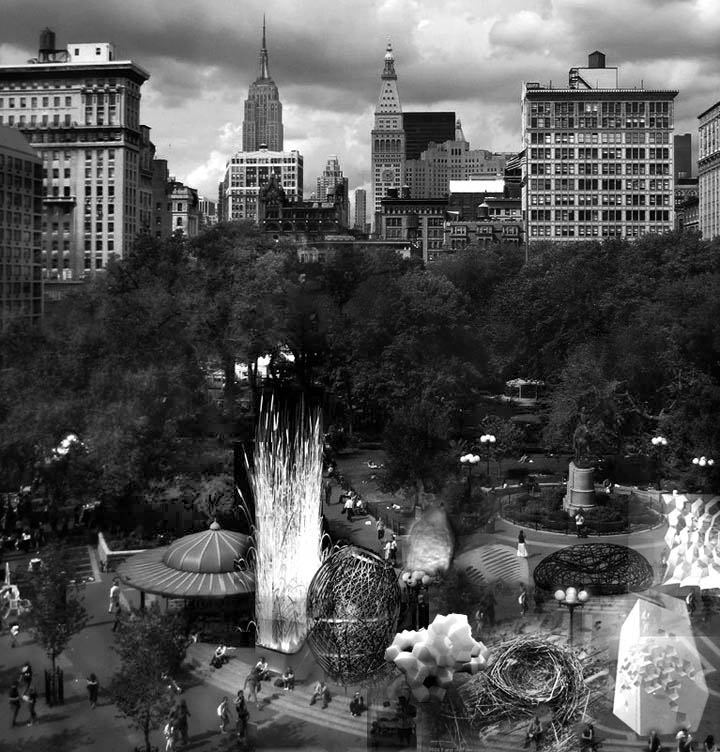Sukkah City
 [Image: Sukkah City as it could be].
[Image: Sukkah City as it could be].Joshua Foer, co-founder of Atlas Obscura and author of the forthcoming book Moonwalking with Einstein, has put together an awesome design competition called "Sukkah City."
A sukkah is a temporary architectural structure with Biblical origins; it is "an ephemeral, elemental shelter, erected for one week each fall," Foer writes, "in which it is customary to share meals, entertain, sleep, and rejoice. Ostensibly the sukkah's religious function is to commemorate the temporary structures that the Israelites dwelled in during their exodus from Egypt, but it is also about universal ideas of transience and permanence as expressed in architecture." The modern-day sukkah is thus both nostalgia and reenactment, substitution and performance (to put it in terms explored by the recent book Anachronic Renaissance).
With this historical background, you can imagine that the brief includes some very particular constraints, design limits that should prove oddly exhilarating to anyone willing to take them on:
- The basic constraints seem simple: the structure must be temporary, have at least two and a half walls, be big enough to contain a table, and have a roof made of shade-providing organic materials through which one can see the stars. Yet a deep dialogue of historical texts intricately refines and interprets these constraints—arguing, for example, for a 27 x 27 x 38-inch minimum volume; for a maximum height of 30 feet; for walls that cannot sway more than one handbreadth; for a mineral and botanical menagerie of construction materials; and even, in one famous instance, whether it is kosher to adaptively reuse a recently deceased elephant as a wall. (It is.) The paradoxical effect of these constraints is to produce a building that is at once new and old, timely and timeless, mobile and stable, open and enclosed, homey and uncanny, comfortable and critical.
More from the brief:
- "Sukkah City: New York City" will re-imagine this ancient phenomenon, develop new methods of material practice and parametric design, and propose radical possibilities for traditional design constraints in a contemporary urban site. Twelve finalists will be selected by a panel of celebrated architects, designers, and critics to be constructed in a visionary village in Union Square Park from September 19-21, 2010.
One structure will be chosen by New Yorkers to stand and delight throughout the week-long festival of Sukkot as the Official Sukkah of New York City. The process and results of the competition, along with construction documentation and critical essays, will be published in the forthcoming book Sukkah City: Radically Temporary Architecture for the Next Three Thousand Years.
And anyone is able to join in—as Foer writes, "If you're an architect, designer, artist, engineer, backyard builder, or just someone with a clever idea, I hope you'll consider entering."





Comments are moderated.
If it's not spam, it will appear here shortly!
Like P.T. Barnum said, a sukkah is born every minute...
Dear Mr. Foer,
I have been following your exciting activities in the New York Sukka City project.
As part of Beit Hatfutsot in Israel, I find great interest in this upcoming event and would like to contact you personally.
I believe both you and Beit Hatfutsot in Israel share a common vision these days.
Thank you,
Michal
michalhom@gmail.com
Very exciting contest- I am really looking forward to seeing the winners... though I must point out my disappointment at the gender breakdown of the judges. Only 3 out of 14 are women, seems like we should have at least achieved 35% female to male ratio. Perhaps next year this contest will represent forward thinking in all aspects of the competition including design inspiration as well as social and political justice.
Post a Comment